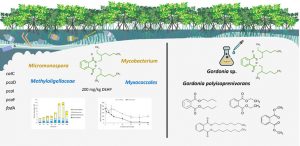Highlight Activities 2025: Biodegradation of di-2-ethylhexyl phthalate by mangrove sediment microbiome impacted by chronic plastic waste
Plastic pollution through the leaching of di(2-ethylhexyl) phthalate (DEHP), a widely used plasticizer, has led to the emergence of mangrove pollution. This study aimed to assess the DEHP removal efficiency of indigenous mangrove sediment microbiomes and identify key DEHP degraders using microcosm construction and metagenomic analysis. During the 35-d incubation period, the indigenous mangrove sediment microbiome, affected by chronic plastic pollution, demonstrated a 99% degradation efficiency of 200 mg/kg DEHP. Spearman’s correlation analysis suggested that Myxococcales, Methyloligellaceae, Mycobacterium, and Micromonospora were potentially responsible for DEHP degradation. Based on PICRUSt2, the DEHP-degrading pathway in the sediment was predicted to be an anaerobic process involving catechol metabolism through catC, pcaD, pcaI, pcaF, and fadA. Efficient bacterial isolates from the mangrove sediment, identified as Gordonia sp. and Gordonia polyisoprenivorans, were able to degrade DEHP (65–97%) within 7 d, and showed the ability to degrade other phthalate esters (PAEs).
สนับสนุน SDGs : เป้าหมายที่ 6 Clean Water and Sanitation, 14 Life Below Water และ 15 Life on Land
อ้างอิง
Saeng-kla, K., Mhuantong, W., Termsaithong, T. et al. Biodegradation of Di-2-Ethylhexyl Phthalate by Mangrove Sediment Microbiome Impacted by Chronic Plastic Waste. Mar Biotechnol 27, 19 (2025). https://doi.org/10.1007/s10126-024-10399-5


